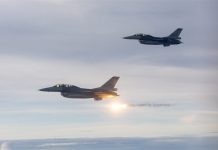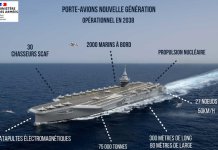An “out of court” settlement has been reached between NH Industries (NHI) and Norway, marking the dramatic conclusion of the country’s more than two-decade-long struggle with the troublesome NH90 helicopter.
Norway and the NHI consortium (comprising Airbus, Leonardo, and GKN Fokker) have agreed to settle mutual claims for damages after Oslo axed the NH90 contract. A joint statement published by the two sides states that NHI would pay Norway €375 million, or about $432 million, in return for all the NH90s to the manufacturer, along with all spare parts, tools, and mission equipment.
“This solution reflects the parties’ mutual agreement to bring all related disputes to a conclusive end,” the statement said. Notably, the returned aircraft and its parts will be recycled back into the program for the benefit of other clients.
The uncanny resolution to what has become the most expensive defence procurement failure in modern Norwegian history comes three years after it nixed the contract, citing years of delays, technical faults, and time-consuming maintenance.
“Regrettably, we have concluded that no matter how many hours our technicians work, and how many parts we order, it will never make the NH90 capable of meeting the requirements of the Norwegian Armed Forces,” the then Norwegian Defense Minister Bjørn Arild Gram said in June 2022.
Norway had signed the initial contract for 14 NH90s in 2001, eight for the Coast Guard and six for anti-submarine warfare duties aboard the Fridtjof Nansen-class frigates in the Norwegian Navy. The acquisition was made to replace the Westland Lynx for anti-submarine warfare, utility, search-and-rescue, and other maritime missions.
The helicopters were originally slated for delivery by the end of 2008, a timeline repeatedly pushed back by the manufacturer. The country received only 13 helicopters, and only eight were delivered in an initial operational configuration (FOC).
Nearly all of these choppers were hit with technical snags and were unable to perform the missions for which they were purchased.
In fact, a 2018 report by the Norwegian Chief of Defense stated that the NH90 helicopters could only deliver the flight hours specified in their operating contract if “enough maintenance frames, good spare parts availability, and a large enough maintenance organization” were obtained.

In the years leading up to its abandonment, the fleet averaged 700 hours annually, rather than the requisite 3900 hours. The aircraft required 30–40 hours of maintenance per flight hour, three to four times more than comparable platforms like the Sikorsky MH-60R Seahawk, as noted in a 2021 Norwegian Ministry of Defence analysis, which attributed the high workload to complex systems, poor avionics reliability, and inadequate technical documentation.
While NHI promised in 2017 to deliver the NH90 in its Final Operational Configuration (FOC) by 2019, it never followed through on that commitment. Additionally, there was a chronic shortage of spare parts. NHI consistently failed to deliver components on time, leading to widespread cannibalization of parts between helicopters.
Environmental challenges further exacerbated issues in the chopper in Norway’s Arctic and maritime climate. There was corrosion on rotor blades, airframes, and engine intakes that accelerated beyond design expectations, while icing on the mission mast and sonar systems frequently caused mission aborts during winter operations, as also noted in operational feedback to NHI.
Norway’s patience ran thin with the aircraft’s underwhelming performance (averaging 100 hours annually towards the end of its service life in Norway) and the contractor’s refusal to honour the obligations.
In February 2022, the Norwegian Defense Ministry asked the Armed Forces, the Norwegian Defence Materiel Agency, and the Norwegian Defence Research Establishment to conduct a thorough assessment of Norway’s maritime helicopter capabilities. According to the assessment, the NH90’s performance and availability could not be improved to meet Norwegian standards, even with substantial additional financial commitments. The fleet was eventually taken out of active service and mothballed.
In 2023, Norway announced the purchase of six US MH-60R Seahawks to replace the unserviceable NH90s. The deliveries of these proven NATO-standard choppers are expected to conclude by 2027.
Norway earlier demanded compensation from NHI of nearly 5 billion kroner ($525 million), an amount that was significantly hiked as the country decided to take NHI to court. The consortium, on its part, pushed back on the compensation amount, arguing that some of these helicopters had already been in service for several years.
The case was poised for a hearing by the Oslo District Court starting on November 10, 2025. Even though portions of the proceedings were scheduled to take place behind closed doors, a state filing referred to the NH90 difficulties as “almost unparalleled in any other contract for the manufacturing of military equipment.”
This would have exposed serious shortcomings, something the consortium probably wanted to avoid.
Australia, Sweden & Belgium Are Done With NH90
The NH90 military helicopter is an advanced multi-role rotorcraft built to NATO’s highest specifications. The NH90, available in two versions —tactical transport (TTH) and NATO frigate helicopter (NFH) —has a fully integrated mission system that enables it to operate in the most challenging environments on land and at sea, day or night.
The helicopter can transport troops, search-and-rescue (SAR), medical evacuation (MEDEVAC), and casualty evacuation, among other operations (CASEVAC). Additionally, it can be deployed for special operations, including counter-terrorism, electronic warfare, airborne command posts, VIP transport, and utility assistance, such as disaster relief. It can transport up to 20 fully outfitted soldiers.
However, it has remained marred by a string of issues that have led to early retirements and the disposal of fleets by multiple operators.
In December 2021, Australia announced it was replacing its fleet of MRH90 battlefield utility helicopters—a local name for the NH90 known as the Taipan—with UH-60 Black Hawks made in the United States, citing maintenance and availability issues.
The decision was made due to the chopper’s tumultuous operational history, characterized by myriad challenges, particularly in sustainment and safety.
In early 2021, the entire fleet of 47 MRH-90 Taipan helicopters operated by the Australian military was grounded due to maintenance and safety concerns related to the aircraft’s support system. Later, in July 2023, one of these choppers tragically crashed into the sea during an exercise, killing all four crew members.
Additionally, Australia concluded that the effectiveness of the MRH-90 was significantly hindered by persistent shortages of spare parts, and a design flaw prevents the operation of a door gun while troops disembark. Moreover, the overall cost of the MRH-90 Taipan program was estimated to reach $15 billion by the initially scheduled retirement in 2037, including $3.7 billion for procurement and $11.3 billion for maintenance.
“The performance of the MRH90 Taipan has been an ongoing and well-documented concern for [the Australian Ministry of Defense], and there has been a significant effort at great expense to try to remediate those issues,” the former Minister for Defense Peter Dutton said earlier. “It is critically important that there is a safe, reliable, and capable utility helicopter available for our servicemen and women into the future, with reasonable and predictable operating costs.”
By December 2023, reports suggested that the country’s Department of Defense had begun dismantling the troubled choppers due to persistent technical issues and a string of mishaps involving them.
It was alleged that the Australian technicians were discreetly disassembling all of the Army’s Taipan helicopters and burying their components at a defense site. Notably, the aircraft was taken out of service a full decade earlier than scheduled and replaced by the US-built UH-60 Black Hawks.
Like Norway and Australia, Sweden also withdrew from the NH90 program. In July 2022, the Commander of the Swedish Air Force, Major General Carl-Johan Edstrom, said at a Swedish Air Force event that the NH90 was not delivering as it should, noting that the service was conducting a comprehensive evaluation of its rotary-wing requirements.
Sweden suffered chronic low availability—often below 30%—due to spare-parts shortages, 25–35 maintenance hours per flight hour, and software glitches. By November 2022, it announced plans to replace its NHIndustries (NHI) NH90 marine helicopters. The Supreme Commander, Gen Micael Bydén, announced that the fleet would be phased out between 2024 and 2030, with full retirement by 2035.
Following the announcement, the Scandinavian country ordered 15 UH-60M Black Hawks as a stopgap to augment its fleet. Unlike Norway, Sweden never cancelled the contract. Instead, Airbus retrofitted all 18 airframes to full operational capability (FOC). The final helicopter was handed over in a ceremony at Marignane on 20 December 2024 and ferried home in January 2025.
Besides these countries, Belgium has also announced its intention to retire the NH90. In July 2025, the country announced that it would retire its remaining four NH90 Tactical Transport Helicopters (TTH) starting September 1, 2025. The decision was attributed to poor maintenance and high costs.
“Bad purchase. Extremely expensive to maintain. Replacements are coming in 2026,” said Belgian defense minister Theo Francken in a post on X.
Although this decision pertains to the four NH90 TTHs used in land missions, the Belgian Armed Forces’ naval branch will retain four additional NH90s equipped for anti-submarine and search-and-rescue missions.
The TTH gap is reportedly to be filled by 15 Airbus H145M light-utility helicopters ordered in June 2024. The first two of these are expected to arrive in December 2026, and all 15 will be in service by 2028.
Several other operators of this controversial platform, including Germany, have reported technical problems in the past. However, the NH90 continues to be operated by multiple countries, and the manufacturer is hopeful of securing new contracts.
- Contact the author at sakshi.tiwari13 (at) outlook.com
- Follow EurAsian Times on Google News




